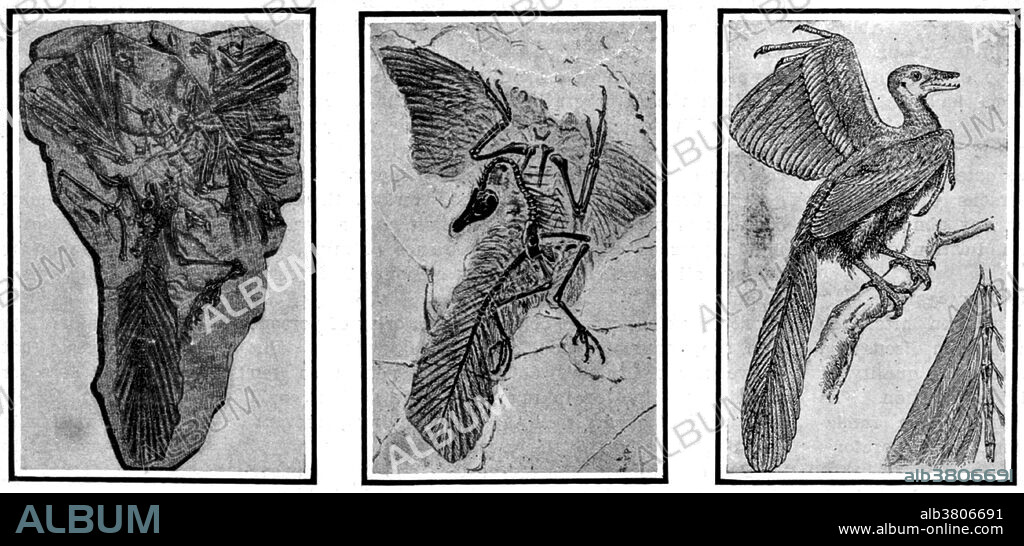alb3806691
Archaeopteryx, Primordial Bird

|
Añadir a otro lightbox |
|
Añadir a otro lightbox |



¿Ya tienes cuenta? Iniciar sesión
¿No tienes cuenta? Regístrate
Compra esta imagen.
Selecciona el uso:

Título:
Archaeopteryx, Primordial Bird
Descripción:
Traducción automática: Archaeopteryx, a veces denominado por su nombre alemán Urvogel (pájaro original o primer pájaro), es un género de aves primitivas que es una transición entre los dinosaurios emplumados y las aves modernas. Vivió en el período Jurásico tardío hace unos 150 millones de años y tenía características tanto de aves como de dinosaurios. Podría crecer hasta aproximadamente 1 pie y 8 pulgadas de largo. A pesar de su pequeño tamaño, alas anchas y su supuesta capacidad para volar o planear, Archaeopteryx tiene más en común con los pequeños dinosaurios mesozoicos que con las aves modernas. Tenía mandíbulas con dientes afilados, tres dedos con garras, una larga cola ósea y segundos dedos hiperextensibles (garra asesina). Muchos científicos lo consideran una prueba de que las aves evolucionaron a partir de pequeños dinosaurios carnívoros. Confirma las teorías de Darwin y se ha convertido en una prueba clave para el origen de las aves, el debate sobre los fósiles de transición y la confirmación de la evolución. Fotografía originalmente titulada: Archaeopteryx, el ave primordial. Figura 1 (izquierda) Losa descubierta en 1861. Figura 2 (centro) Losa encontrada en 1877. Figura 3 (derecha) Reconstrucción ideal, 1911
Archaeopteryx, sometimes referred to by its German name Urvogel (original bird or first bird), is a genus of early bird that is transitional between feathered dinosaurs and modern birds. It lived in the Late Jurassic period around 150 million years ago having characteristics of both birds and dinosaurs. It could grow to about 1 foot 8 inches in length. Despite its small size, broad wings, and inferred ability to fly or glide, Archaeopteryx has more in common with small Mesozoic dinosaurs than it does with modern birds. It had jaws with sharp teeth, three fingers with claws, a long bony tail, and hyper-extensible second toes (killing claw). Many scientists regard it as evidence that birds evolved from small carnivorous dinosaurs. It confirms Darwin's theories and has become a key piece of evidence for the origin of birds, the transitional fossils debate, and confirmation of evolution. Photograph originally captioned: Archaeopteryx, the primordial bird. Figure 1 (left) Slab discovered in 1861. Figure 2 (center) Slab found in 1877. Figure 3 (right) Ideal reconstruction, 1911.
Crédito:
Album / Science Source / New York Public Library
Autorizaciones:
Modelo: No - Propiedad: No
¿Preguntas relacionadas con los derechos?
¿Preguntas relacionadas con los derechos?
Tamaño imagen:
5400 x 2600 px | 40.2 MB
Tamaño impresión:
45.7 x 22.0 cm | 18.0 x 8.7 in (300 dpi)
Palabras clave:
ANIMAL • ANIMALIA • ARCHAEOPTERYX • AVE • AVES • BIOLOGIA • BLANCO Y NEGRO • CHORDATA • ESQUELETO • EVOLUCION • EVOLUCIONISTA • EXTINCIÓN • EXTINGUIDO • FÓSIL • FOSILIZADOS • FOTO • FOTOGRAFIA • HUESO • HUESOS • JURÁSICO • LOSA • ORIGEN • ORIGINAL • PAJARO • PERIODO JURASICO • PREHISTORIA • PREHISTORICO • PRIMERO • RECONSTRUCCION • S. XX • SIGLO XIX • SIGLO XX • ZOOLOGIA
 Pinterest
Pinterest Twitter
Twitter Facebook
Facebook Copiar enlace
Copiar enlace Email
Email
